#Imperial pearl earrings collection
Explore tagged Tumblr posts
Text
Focus on Your Style with TheJewelryHut Designer Vintage Inspired Style Freshawater Pearls and White Topaz Silver Earrings

Beauty Should have no Boundary, and You Never have to Sacrifice when choosing a gemstone Earrings. Trust, Confidence, and Integrity. Capture Her Heart with Thejewelryhut Fancy designer Vintage Inspired Style Freshwater Pearls, The Treasures of the Sea, in 925 Sterling Silver Lever Back Earrings adorned with Two Genuine White Freshwater Pearls, and Surrounded by Several Round Shape White Topaz. The oriental pearl is known as the gem of the moon. They have been recognized as the emblem of modesty, chastity, and purity. They have also come to symbolize a happy marriage. Pearl is the birthstone for June and is among the most timeless, classic, and treasured of all gems and is the recommended jewelry gift for celebrating 3rd, and 30th wedding anniversary. Ready to ship in 3-5 Days.
If Not Now? Then, When? Shop TheJewelryHut Jewelry Gallery, and Order online Now: https://www.thejewelryhut.com/?page=search&itemvid=16C09DA7-A263-3FF9-25852A75DE9AF35E
#earrings#earring#pearl earrings#pearl and diamonds earrings#sterling silver earrings#sterling silver earring#14 kt gold earrings#freshwater pearl earrings#akoya pearl earrings#tahitain pearl earrings#halo style earrings#dangle pearl earrings#pearl stud earrings#anniversary jewelry gift#birth stone pearl earring#june birth gemstone earrings#black dress event jewelry gift idea#jewelry near me#thejewelryhut. Jewelry on sale#Imperial pearl earrings collection
0 notes
Text

The Imperial State Crown was made in 1937 by Garrard for the Coronation of King George VI. The design of the crown was based on Queen Victoria’s Imperial State Crown made for her Coronation in 1838.
The crown is set with diamonds, rubies, emeralds, sapphires, spinel, and pearls but is also features several important jewels.
The cross at the top is set with St. Edward’s Sapphire, said to have belonged to Edward the Confessor.
Four pearls hang from the center which were a wedding gift to Catherine de Medici from Pope Clement VII. They are said to have been worn as earrings by Queen Elizabeth I.
The front is set with The Black Prince’s Ruby which is actually a spinel that belonged to Don Pedro, King of Castile. Just below is the Cullinan II, a 317.4 carat diamond presented to King Edward VII.
At the back of the crown is the Stuart Sapphire, from the collection of King James II.
49 notes
·
View notes
Text
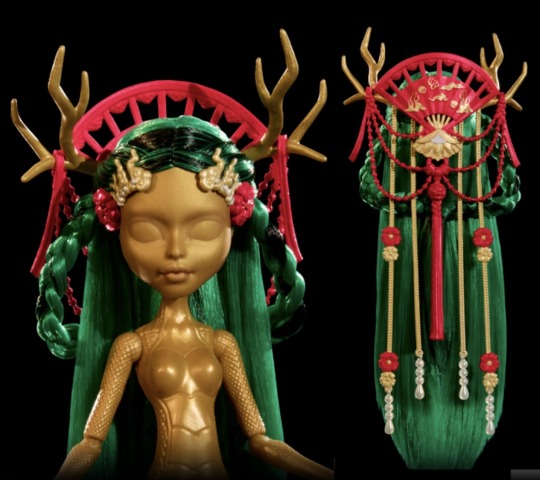

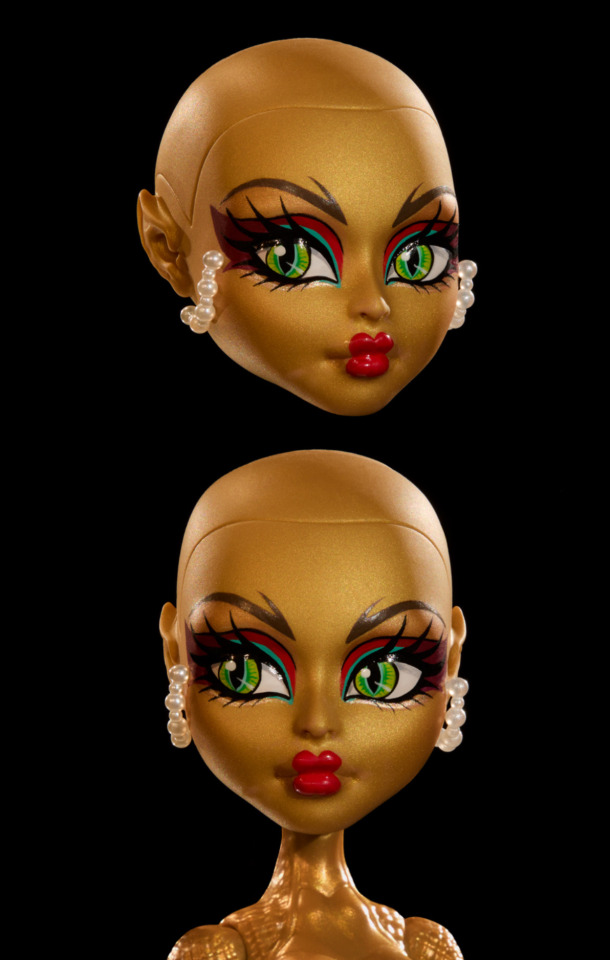
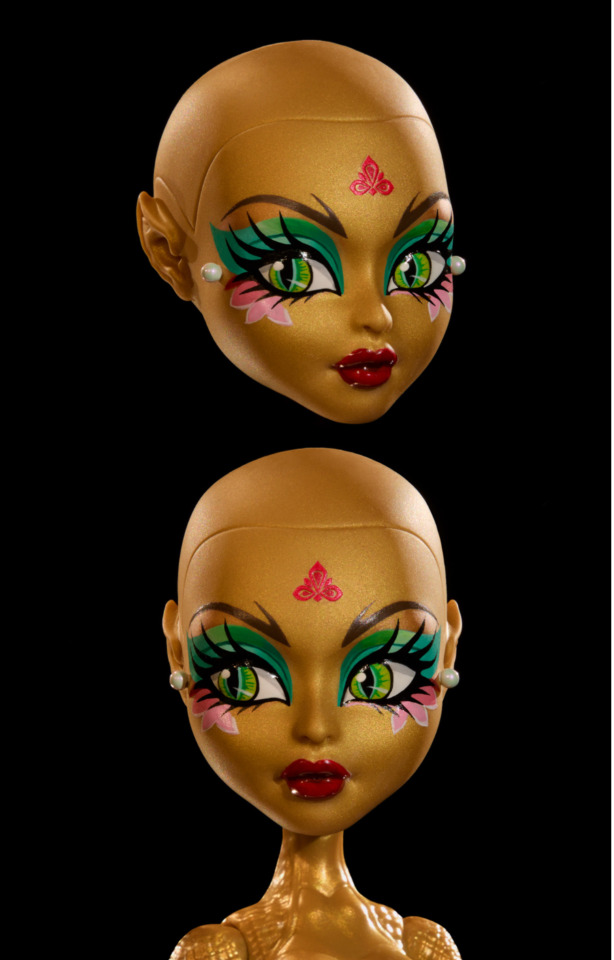


here are the Fang Vote options for Jinafire Long, ripped from Mattel Creations’ forums. they’re just screenshots, so bear with me. the design notes are below, from right to left.
Hairstyles:
Mythical Muse
Strewn with plum blossoms and dangling pearls, this dreamy, braided look is a modern interpretation of traditional head wear, infusing dragon elements and modern chain drapery.
Eternal Icon
The high ponytail gets a historic inspired makeover with a twin dragon caged headpiece, decorated with ornate pearls and floral detailing.
Makeup:
Ember Empress
Talk about a smoldering gaze!
With crimson eyeshadow and bold lips, this regal, pearl-draped lurk is so blazingly bold, it's on fire.
Imperial Gardens
With a huadian on her forehead and lotus petals blooming across her cheeks, this makeup takes "natural beauty" to a whole new level.
Jewelry and Nails:
Floral Opulence Collection
An elegant, cloud-inspired arm cuff lends an ethereal touch to gold floral earrings and jade nails.
Fiery Splendor Collection
Scarlet nails and an arm cuff of dancing flames complement tasseled earrings adorned by a jade dragon amulet.
34 notes
·
View notes
Text
The many, many references of chapter XI of Dorian Gray
This chapter can come across as a bit of a long, boring list of stuff. That's partly because it is a long, boring list of stuff, as we see how shallow Dorian's life of collecting trinkets and misdeeds is, compared with his lofty ambitions to be some kind of thought-leader of his age.
But it's Wilde, so a lot of this chapter has references and connotations that might not be obvious.
the sordid room of the little ill-famed tavern near the docks OK, this isn't particularly subtle given Wilde already tells us it's sordid and ill-famed. But it's probably not just a dodgy pub. Being near the docks implies that Dorian is hanging out with people in the lower classes, almost certainly including sex workers. I think there might also be a nudge-nudge wink-wink implication of homosexuality here - docks mean sailors, and the navy already had a reputation for homosexuality in Wilde's time.
Like Gautier, he was one for whom “the visible world existed.” Théophile Gautier, a French writer, critic and defender of Romanticism. He was flamboyant, unconventional and had lots of affairs.
he might really become to the London of his own day what to imperial Neronian Rome the author of the Satyricon once had been The author of the Satyricon is Petronius, a Roman courtier in the reign of Nero. He was dedicated to a life of pleasure and indulgence, and was an authority on questions of fashion and taste.
the materialistic doctrines of the Darwinismus movement in Germany Darwinismus means proto-eugenics, essentially. You know, in case you needed any more reasons to dislike Dorian.
the one that Bernal Diaz saw when he went with Cortes into the Mexican temple, and of whose doleful sound he has left us so vivid a description "They had an exceedingly large drum there, and when they beat it the sound of it was so dismal and like, so to say, an instrument of the infernal regions, that one could hear it a distance of two leagues, and they said that the skins it was covered with were of those great snakes." Wouldn't say it was that vivid a description, to be honest.
appeared at a costume ball as Anne de Joyeuse, Admiral of France, in a dress covered with five hundred and sixty pearls Despite how this sounds, Anne de Joyeuse was a man, and Dorian didn't go to the ball in drag. Anne de Joyeuse was probably one of Henry III's lovers. (This is the start of a theme developing).
Alexander, the Conqueror of Emathia This is Alexander the Great. (The theme continues).
Lodge’s strange romance ‘A Margarite of America’ A 16th century romance about the love affair between a Peruvian prince and a Russian princess. With a lot of gory bits.
the Duke de Valentinois, son of Alexander VI Otherwise known as Cesare Borgia, who inspired Machiavelli to write The Prince. There are all sorts of rumours about Cesare Borgia, ranging from having lots of mistresses (true) to gay relationships and incest with his sister (probably not true).
Charles of England had ridden in stirrups hung with four hundred and twenty-one diamonds This is presumably Charles I rather than Charles II (who was also Charles of England). Historic Royal Palaces - the people who run the Tower of London, among others - have him on their list of LGBT+ monarchs. They highlight this painting, where he's gazing at George Villiers, who also shagged his dad:
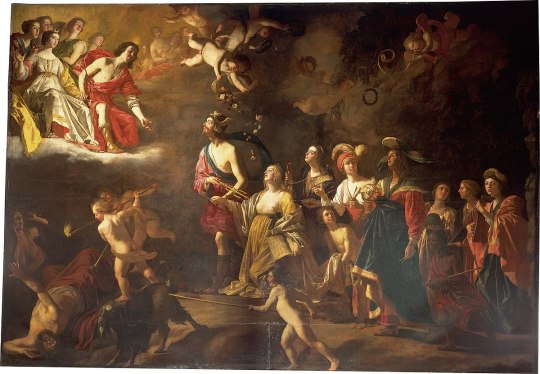
Richard II had a coat, valued at thirty thousand marks, which was covered with balas rubies Richard II, who was rumoured to have had an affair with Richard de Vere, Earl of Oxford.
Henry VIII Who only had relationships with women, as far as history is aware.
The favourites of James I wore ear-rings of emeralds set in gold filigrane Back on the theme again. James I was Charles I's dad, who had a secret passage built between his bedchamber and that of his favourite, George Villiers - the one in the picture up there ^. While most of the people on this list were only rumoured to have had gay relationships, no one really disputes it for James I.
Edward II gave to Piers Gaveston a suit of red-gold armour That would be his lover, Piers Gaveston.
Henry II. wore jewelled gloves reaching to the elbow Henry II, who was known to have shared a bed with William Marshal, the Earl of Pembroke. Which doesn't necessarily mean anything, but... you know. There's a theme.
Charles the Rash, the last Duke of Burgundy of his race At this point I can't tell if Wilde is deliberately throwing in some misdirection, like the mention of Henry VIII, or if my Google-powers have failed me.
the mortuary cloth of King Chilperic Oh hang on a tick. King Chilperic was a 6th century monarch who is known, among other things, for having strangled his wife. Just as Henry VIII had two of his wives executed. So the theme here is either queer relationships - or murdered women.
(We then of course get a series of notable historical figures who, so far as I can tell, don't have any connections to either of these things. Also this bit goes on for ages and this post is already very long, so I'm going to skip past them).
dreadful places near Blue Gate Fields A slum area just north of the docks in East London. Known for opium dens, brothels and murders. Some people have suggested this is an allusion to Jack the Ripper, even a suggestion that Oscar Wilde knew who Jack the Ripper was, which I'm reasonably confident is nonsense.
brawling with foreign sailors in a low den in the distant parts of Whitechapel So what I'm finding quite funny here is that all the dodgy and dissolute places that Wilde has Dorian go are literally just the same place.
Near the docks = East London, probably in the area of Whitechapel Blue Gate Fields = Whitechapel the distant parts of Whitechapel = that would be Whitechapel, then?
The very odd Jack the Ripper website I just read interprets Wilde's descriptions as meaning that he had some kind of hidden knowledge of London's underworld... just as the Ripper would have!! But to me this reads a lot more like Wilde was aware of one (1) suitably shady-sounding location and ran with it.
Here was Philip Herbert That would be James I's lover, Philip Herbert. (What, you thought we were done with these?)
Sir Anthony Sherard Is fictional, but...
the lover of Giovanna of Naples Giovanna of Naples was a real person, who probably murdered her husband. (Nice to get some variety among the murdered spouses).
Lady Elizabeth Devereux A Tudor noblewoman, known for a quite public affair.
George Willoughby... had been a macaroni of the eighteenth century, and the friend, in his youth, of Lord Ferrars I can't find much on George Willoughby, but Lord Ferrers shot his steward, and is known as the last peer to have been hanged in England.
the second Lord Beckenham... he had led the orgies at Carlton House Lord Beckenham is (I think) fictional; George IV, who held wild and extravagant parties at Carlton House, is not.
Tiberius, in a garden at Capri Googling this brings up articles titled things like "The Scandalous Private Life of Tiberius Caesar". That makes it sound like the fun activities of consenting adults, but that's grossly misleading. The people involved were rumoured to be often neither consenting nor adults.
reading the shameful books of Elephantis Elephantis was a Greek poet and physician who wrote a sex manual.
Caligula... Domitian... Elagabalus Caligula was known for sex and murder. Domitian was known for censorship and control of public morals. Elagabalus was known for sexual promiscuity with men and women.
And that's the lot! For the last few paragraphs of the chapter, Wilde actually spells out the various misdeeds of the people he discusses (sex and murder, unsurprisingly), thus sparing me from Googling them.
Congratulations if you made it this far.
62 notes
·
View notes
Text
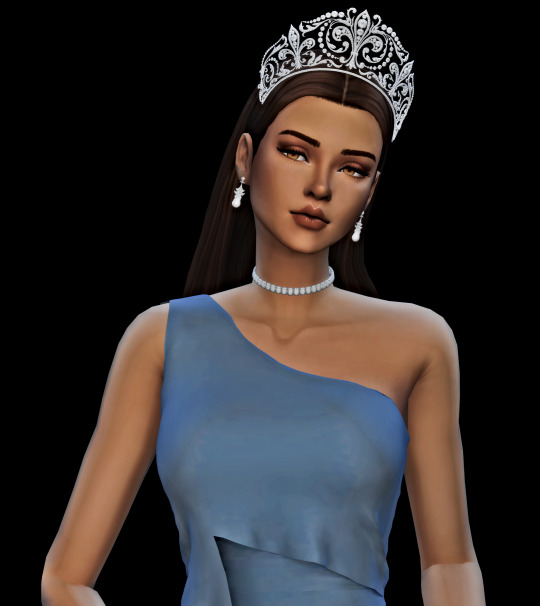
The Crown Jewel Edition: Queen Consort Ana
From State affairs to private soirées; this is an inside look into Queen Ana's favorite pieces within the Lunarian Royal Collection.
The Fleur-de-lys Tiara (Above)
This particular piece was featured at many a State Banquet and in several of Her Majesty's official portraits. Originally crafted in Pierreland by Maison de Lumeniere, the tiara was commissioned by Crown Prince Jean Charles Valois in 1874 to commemorate diplomatic relations with Lunaria. It had been worn by Queen Consort Katrina and her daughters before falling out of favor in the early 1900s, when kokoshniks became the trend for the Royal Family. Queen Ana first brought it out of obscurity in the 1970s while attending a State Banquet in Rivenia as a part of her Marriage Tour.

The Ely Meander Tiara
Gifted to Queen Clarisse in the late 1950s by the 10th Duke of Ely, this tiara was personal gift to Ana when her engagement to then-Crown Prince Vincent was announced. She most notably wore the piece during both her husband's Silver and Golden Jubilees. Her Majesty gifted the tiara to her only daughter – and now the Queen of Windsor – Ashli, who wears it frequently for official portraits.
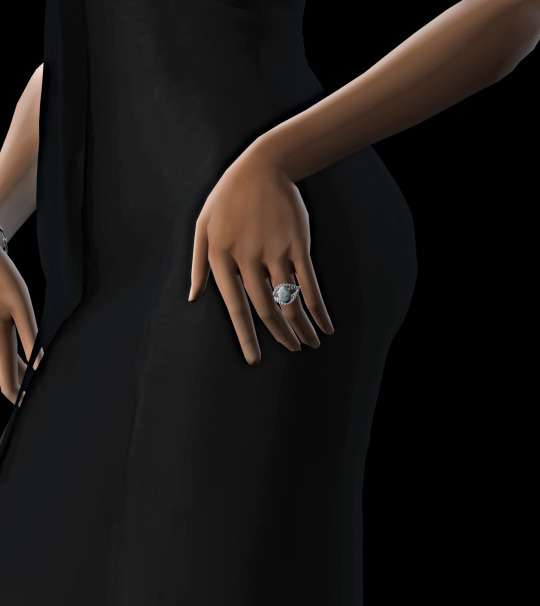
Queen Ana's Engagement Ring
Designed personally by then-Crown Prince Vincent using a large, 12-carat aquamarine surrounded by thirty-six diamonds on a split-shank design, Queen Ana's engagement ring was a stunning piece that many ladies in Lunaria were jealous of. The ring was returned to the Royal Vault upon her death twenty years ago, where it will remain alongside other Royal engagement rings.

The Brindleton Sapphire Kokoshnik Tiara
This piece was bought during a private auction of the Brindleton Empire's Royal tiaras. The auction was rumored to have occurred because of Emperor Alaric's overspending of the National Treasury. Although the rumors were never confirmed, several high profile pieces from the Imperial Family's collection were sold to other families around the world, shaming Emperor Alaric, whom also sold several of his wife, Empress Amira's, personal jewelry inherited from her family. The purchase of the kokoshnik and other pieces apparently soured his relationship with King Vincent and Queen Ana in the coming years.
Adding insult to injury, Her Majesty wore the kokoshnik to a banquet celebrating Brindleton's surrender to the combined military forces of Windsor and Lunaria during Windsor's War for Independence. The Brindleton Empire has remained a military and political rival of Lunaria ever since.
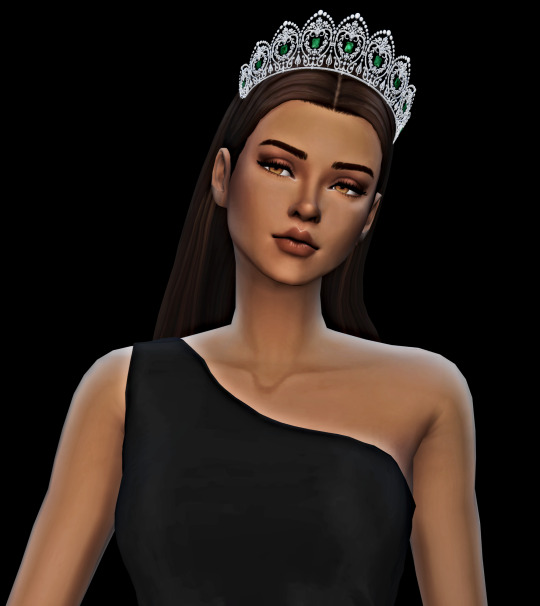
The Belvedere Palm-Heart Tiara
This piece was a gift to Queen Consort Lilith–then the Duchess of Belvedere–in 1793 as a wedding gift from the province her husband ruled over. It features nine emeralds sourced from the area and was designed to look like the palm-heart flowers native to the land.

The Honeysuckle Loop Tiara
A diamond and platinum piece which originally belonged to the Brindleton Imperial Family like the Sapphire Kokoshnik listed above. Her Majesty often wore the tiara for foreign formal events.

Queen Katrina's Pearl Wedding Earrings
Originally worn by Queen Consort Katrina in 1841 on her wedding to then-Crown Prince Edward (soon-to-be known as the Mad King Edward IV), these earrings were originally part of a lovely parure. The necklace, bracelet, and tiara were unfortunately lost in a fire at Windenburg Palace in the early 1920s.
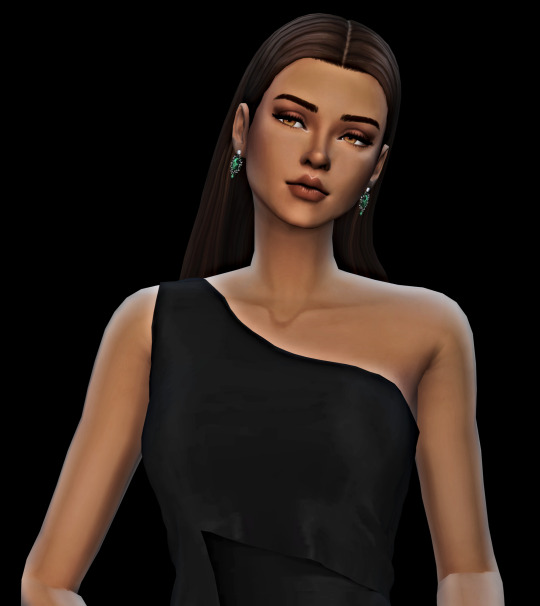
Queen Ana's Emerald Laurel Earrings
These earrings were bought by the Queen before she married into the Royal Family. They were designed by court jeweler Simtier from their Mythic collection and were purchased privately by Her Majesty for §30,000. They remain within the Quinn family's private collection and are being kept by King Arden currently.

Queen Ana's Birthday Earrings
A gift to the Queen Consort from her three children, these earrings were her most beloved pieces of jewelry. The earrings are another Simtier piece, personally designed for her, and were passed down to her eldest son's wife after her death.
The earrings were most recently worn by Princess Annaliese, who wore them for her eighteenth birthday celebration.
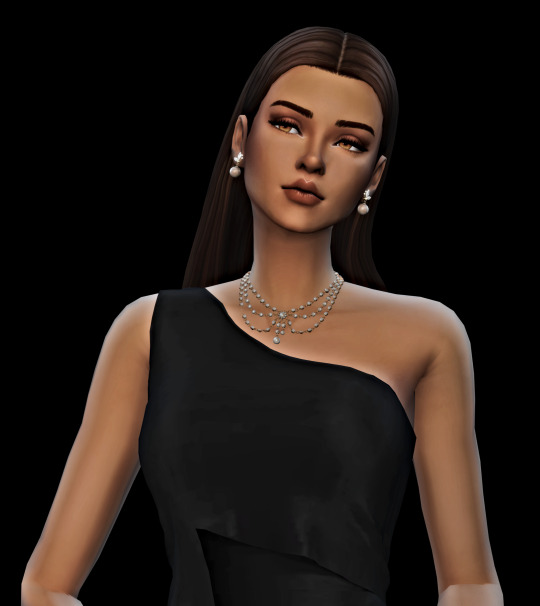
The Piraeus Pearl Set
This pearl necklace and earrings set are a Harold family heirloom. Upon her father's death she was able to inherit a few key pieces after his Earldom was dissolved back into the Crown. Her Majesty only wore the set for intimate private events.

Bordeauxian Pearl Wedding Necklace
This necklace is one of the oldest pieces within the Royal Collection, dating back almost six hundred years, and is a wedding gift from King Francois of Bordeaux to Queen Consort Marylene.
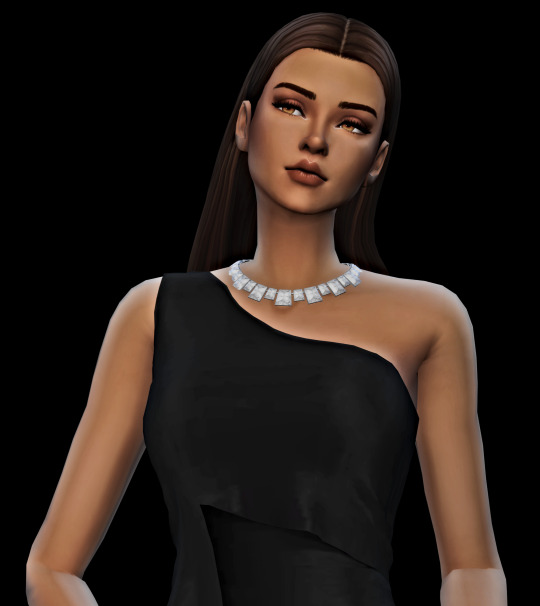
The Celestri Diamond Alliance Necklace
This necklace, which consists of millions of simoleons worth of Celestri Diamonds, was once one of the Celestre Imperial Family's prized jewelry pieces.
The necklace was given over as a part of peace negotiations twenty years after Lunaria split from the Empire of Celestre. The Emperor at the time, Nikolas II, was the half-brother of the first King of Lunaria, Rhysander I, and regretted the War of Secession that occurred between the two nations after a personal dispute between the two.
Queen Ana wore the necklace most famously during the funeral of her in-laws, the former King Richter and Queen Clarisse, but was often depicted wearing it during official portraits. The necklace has also been continuously worn during official visits to Celestre.
27 notes
·
View notes
Text
Kulîlk Teyran
This is my Crown from an interactive novel made by Cherry @ataleofcrowns , I highly recommend trying it out if you have free time! (It’s also an IP I write for too so go wild)

(Picrew)
Name Meaning: Flower, Blossom
Age: 25
Birthdate: 527 AE, 12 Mourning Embers (Dec 27th)
Pronouns: She/Hers
Height: 155 cm/ 5′1″
Appearance: Sun-kissed golden brown skin with golden eyes. Hip-length, straight black hair that is held half up, half down. Often decorated with a flower or hair ornament. Short in stature with long legs and arms, a slight amount of muscle definition visible, suffered from malnourishment in the past before becoming Crown. Prefers long, ornate dresses with a fair amount of accessories most days. When traveling, opts for a light linen tunic and shalvar. Regardless of attire, keeps a dagger of pearl hidden on her at all times.
Noticeable Attributes: Deep dark circles underneath her eyes, a few semi-hidden strands of silver in the hair
Default Expression: Forlorn when alone, though quick to light up into a gentle smile when people are near
Magical Ability: Inner
Magical Signature: Death of the Sun
Character Traits: Charming, Kind, Adventurous, Passive, Reserved
Description:
A record by the scholar Erez Barzanî on the preferences and behaviors of the Twenty-First Crown of Arsur. (Template by @tath-draws)
While the Twenty-First Crown of Arsur comes from humble origins and likely did not have the luxury of leisure, now they have it. With their newfound wealth, her imperial majesty can often be found reading or tending to the palace gardens, by her own account her enjoyment of gardening stems from her background as a farmer. Crown Kulîlk is also known to have a fondness for archery and song as well.
In the mornings, her imperial majesty rises with the sun itself. She prefers a savory breakfast, as well as her other meals, and has shown herself to be rather adventurous in the foods she’s willing to try- though she has a strong distaste for olives in any form. The foods she loves above all seem to be borakê penêr and freshly made kilorîk, especially in the morning. When she does consume sweets or fruits, her imperial majesty pairs it with a bitter, floral blend of black tea she often drinks.
For her taste in clothing, Crown Kulîlk prefers silk dresses in light shades of blue or pink. And for adornments, her imperial majesty prefers to wear accessories in moderation, save for days of importance where she will apply a full set of regalia. Though her imperial majesty prefers gold pieces, most of her collection is reportedly too “opulent” for her tastes, her imperial majesty stating that “there were simply too many gaudy gemstones” for her liking. Out of all her accessories, she holds a fondness for necklaces and earrings- especially those gifted to her by friends. She tends to wear her hair half done up, with a hair ornament or a fresh flower from the gardens adorning her. She seems to care for appearances overall, citing a need to present herself well to her people, and tends to dress as elegantly as she can.
In conversation, she is found to be charming and mindful, as if you held her full attention and confidence when speaking with her. If you are close to her imperial majesty, you can often smell various sweet, fragrant blossoms, depending on the season, though her favorite appears to be apple. I imagine if one were to be able to have a private audience with her, they would find her majesty amiable and empathetic if initially quiet and shy, those close to her noting the ease with which she laughs and smiles when out of court. (I also recall them mentioning a fear of deep water once.) And when idle, her imperial majesty has a tendency to bounce her leg, though she is quick to still herself when in the presence of others outside her inner circle. Generally, her expression can be described as sweet and soft, though there are reports from the servants of Crown Kulîlk claiming that she often appears burdened or saddened in private.
She seems most accustomed to travel and has developed a fondness for her horse, Aram. She seems especially enthused when learning and honing her martial skills, her imperial majesty utilizing her training as a chance to vent her frustrations with her Royal Protector.
In regards to magic, she shows fascination and a hunger for knowledge, showing a predilection toward inner magic. Her imperial majesty seems set on strengthening her use of outer magic as well. Though, from an inspection of the increased invoices for replacement furniture and books, her studies may be in their earliest stages.
When I asked her, she said her fondest memory of their parents was on her sixteenth name day, their parents risking exposure to the Followers of Vidarna in order to purchase her favorite pastries and spend a day in the city with the young Crown-to-be after years of nonstop traveling. According to Crown Kulîlk, this is where her fondness for borakê penêr comes from.
Her imperial majesty seems close with her four most trusted companions, the Pale Sword, her General, her Sorcerer, and her Royal Protector. She appears excited at the prospect of having tea with the Sorcerer and Royal Protector every morning and sparing a meal with her General each day to hear of their reports and catch up. However, her imperial majesty seems especially close with the leader of the Crescent Blades, often witnessed leaving the palace to spend her free time with them. Overall, Crown Kulîlk is quite generous and attentive to her serving staff and all those working in the Imperial Household, doing her best to remember as many names and faces as possible.
In the evenings when they are not busy with the duties of the crown, they can be found dining with her close friends, or when they are busy, spending her time in her chambers writing in her journal and working or studying. She tends to retire to her bed chambers to sleep late into the night, spending the extra time awake working on what she can for the next day.
Above all else, this crown appears to be an impassioned, yet gentle leader. And I can say with sincerity that I look forward to further learning about her and her reign to come.
Bonus Information:
MTBI: INFJ-T, the Advocate
Temperament: Melancholic
Zodiac: Capricorn Sun, Cancer Moon, Gemini Rising
Alignment: Neutral Good
Greatest Assets: Compassion and Earnestness
Greatest Flaws: Isolative, Unforgiving
#A Tale of Crowns#atoc#fan crown#my oc#oc#kulîlk teyran#Im gonna start taking requests for this oc now btw ^^ Id be down to answer questions and write#this became way more detailed than intended lol#the picrew didnt have the right skin tone rip
17 notes
·
View notes
Text
The imperial state crown, the latest incarnation of which has been resting on the Queen’s coffin as thousands of people have filed past this week, has witnessed many resonant moments in history, and a few less majestic ones too.
After the death of the Queen’s grandfather, George V, for instance, the king’s coffin was being transported from London’s King’s Cross station with the crown on top when the jolting of cobbled streets caused the diamond-encrusted globe on top, and the cross and sapphire it supports, to snap off and roll into a gutter.
Though it was hastily retrieved, the dead monarch lay in state under a mutilated crown, which many in the crowd, including the new king, Edward VIII, took as a bad omen. Eleven months later, sure enough, he abdicated.
The tradition of crowns representing royalty is “a time-honoured thing seen in cultures across the world and through deep time”, says Anna Keay, a former curator at the Tower of London who has written the official guide to the crown jewels. “The business of wearing something on your head that speaks of your status as a special person – we see it through millennia.”
In other words – enchanting or repulsive – the vast, ridiculous excess of the crown’s 2,868 diamonds, 17 sapphires, 11 emeralds, four rubies and 269 pearls is its symbolic point. These are some of their stories.
1 St Edward’s sapphire
This may be the oldest stone in the crown, having been buried as a ring, according to legend, with King Edward the Confessor in 1066 (and dug out of his grave a century later). Edward had given the ring to a beggar, the story goes, who turned out to be St John the Evangelist. The remarkable Wilton diptych, now in the National Gallery, shows an image of Edward as a saint holding an apparent sapphire ring.

“The difficulty is it’s very hard to identify any of these gems to say confidently that they are the ones from before,” says Keay, now director of the Landmark Trust. In the case of the sapphire, disappointingly, “I don’t think the case is very strong … In crown terms it’s quite small. Obviously in everyone else’s terms, it’s enormous.”
2 Queen Elizabeth’s earrings
The imperial crown is so named not because of the British empire, but because of its closed-arch form, which Henry VIII adopted (instead of an open coronet) to signal his supposedly imperial status. Dangling from the centre of the arches are four large pear-shaped pearls.
According to the Royal Collection Trust, these have been linked to seven pearls that Catherine de’ Medici gave to her daughter-in-law, Mary, Queen of Scots. Elizabeth I may have later worn them as earrings, though she apparently preferred pearls on her costume.
On the other hand, notes the trust, “it appears that at least two of the pearls did not enter the collection until the 19th century”, which undermines some of the Elizabethan romance.
3 The Black Prince’s ruby
Actually a 170-carat spinel, it is certainly a very ancient unfaceted jewel that was pierced at some point in its history (a little visible lump is in a ruby plugging the hole). The Black Prince is said to have demanded the stone in exchange for helping Peter of Castile (variously known as “the Just” or “the Cruel”, depending on one’s point of view). Peter had taken the ruby from Abu Said, the ruler of Granada, after stabbing him to death as he was trying to surrender, which may settle the question of the nickname.
A delightfully dated 1960s film available on YouTube shows the Queen talking about the crown, saying of the ruby: “I always like to think of it being worn by King Henry V during the Battle of Agincourt.” Richard III may also have had it on his helmet when he was killed at the Battle of Bosworth, the Tudors retrieving it before it ended up in a car park.
4 Cullinan II
So named because, even at a boggling 317 carats, it is not the biggest jewel cut from the Cullinan gem, the biggest uncut diamond ever discovered. That, at 531 carats, is in the Sovereign’s Sceptre, also currently perched on top of the coffin in Westminster Hall.
Though some in the continent would undoubtedly welcome it back, the “second star of Africa” does not have a particularly disputed origin – unlike the Koh-i-noor diamond set in the Queen Mother’s crown, which very much does. It was found at a mine in South Africa in 1905 – “apparently [the manager] just dug it out of the rock face with his walking stick,” says the Queen in the video. The government of Transvaal bought the stone and presented it to Edward VII on his 67th birthday.
“There are two smaller pieces,” the Queen continues, “which my grandmother always referred to as ‘the chips’.”
0 notes
Text
Pearl Long Set Design - Kundan Long Set Jewellery - Kundan Long Set Online Shopping
Pearl Long Set Design - Kundan Long Set Jewellery - Kundan Long Set Online Shopping
Pearl Kundan Layered Long Set at Ornnaz Artificial Jewellery is at very affordable price…
Pearl Long Set jewellery is believed to have its roots in the royal courts of Rajasthan and the craft further prospered under the patronage of the Mughal royals.

Pearl kundan layered long set are for bridal, bridesmaid and bride’s mother or aunties. On Bridal’s special day she wears long set to make her look gorgeous. The bride can wear pearl long set in different functions likes wedding, engagement, tilak, sangeet, haldi, mehendi, shadi and reception. Bride looks good by wearing pearl kundan layered long set in function.
There are many varieties in Pearl kundan layered long set like…
Elephant Design Kundan Long Set Jhumka Style Earrings:
An Elephant Design Kundan Long Set jhumka style earrings is the Ethnic multi-layered necklace. This necklace set for wedding occasions. Elephant Design Kundan set wears bride, women and girls. This necklace is perfectly suits on traditional dress. This necklace wears every occasions like festive, wedding etc. Its looks stunning on any function.
Peacock Design Long Necklace Set Matte Finish Jewellery:
A peacock design long necklace set matte finish jewellery that is more attractive when bride wears on her special day. And dulhan looks good-looking in this necklace. Beautiful Peacock design layered pearl long set in wears in many occasions saree, lehenga, choli etc. these set gives eye-catching look on every functions. Its material base is copper.
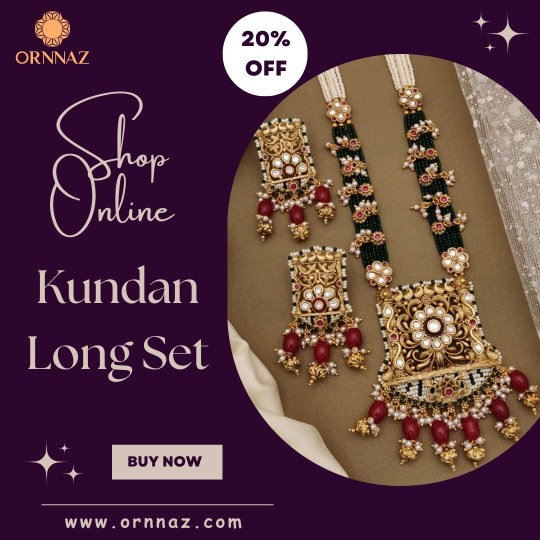
We give finishing of semi gold plated therefore its look classy, royal and makes your traditional look more attractive. In this set 1 necklace and 1 pair of earrings. Kundan Long Set Online Shopping of trending design for upcoming festive season.
Meenakari Matte Finish Peacock Design Set:
A meenakari design long necklace set matte finish jewellery that is so vast collection, when bride wears on her exceptional day. Meenakari Matte finish designs wears in festive, wedding etc. these set gives stunning look on every occasions. We give finishing of semi gold plated thus, its looks fashionable on her big day. In this set there is used many Colorful stone and more color pearl beads.
Mango Design Long Set with Jhumka Earrings:
A mango design long set is the wonderful for any occasion. This necklace wears in traditional Navratri function, reception and any other event. This necklace comes with an attractive pair of jhumka earrings that add the ideal finishing feel to royal and stunning look. Pearl long set necklace is shine in every occasion no matter where you go. This necklace is gives it an imperial and comfy feel and it is ideal for a woman and girls on saree, choli and lehenga.

There are many types of Pearl kundan layered long set. Presently, jewelry can still be seen as a sign of victory. But it can also be a significant way to express your uniqueness. People wear jewelry for many reasons.
We may take out the pearl Kundan Long Set necklace and other favorite diamond collar necklaces, only for special occasions. But it is the long necklace that we reach for when it is for daily wear, causal evening out with friends, or to match our office event. There are more than a few long design necklaces crafted with great awareness to beauty that become signature pieces surrounded by women.
Showcase, your exclusive style and allure with this designer floral necklace set. Pearl kundan long necklace set is just right to wear with South Indian traditional saree. And matching earrings in this set are also a wonderful adding together of any matte finish jewelry collection. Kundan long set is make you royalty looks and for marriage function to match with the costume.

In this kundan long set fashion jewelry with a beautiful daisy-shaped pendant. The combination of the long necklace and the stunning pendant, along with the matching earrings, creates a surprising and stylish look. The pearl long set gold plating adds a touch of comfort and complexity to the set, pretty its overall appearance.
People buy jewellery because it’s stylish to wear, it has long lasting value and it connects people across generations and also they know they can look stunning in it. When this necklace wears any girl or woman she has been associated with much positive emotion such as happiness, sense of worth, and confidence. It has also been linked to feelings of authority, conquest and achievement.
It’s important to keep in mind that you will get discount on the original value of the kundan long necklace set. So, get ready yourself and confirms orders in real-time or as soon as possible.
#Pearl Long Set#Kundan Long Set#Kundan Long Set Online Shopping#kundan necklace#kundan jewellery#pearl necklace#necklace
0 notes
Text
Day 5 Reluctant
Third Prince Jin Guangyao is betrothed to Imperial Advisor Lan Xichen.
(Arranged marriage)
Lan Xichen smiled gently in thanks at the maid who'd just finish affixing the red and black guan for him, dismissing her.
Sweeping up his sleeves to keep them clear as he brushed off a fallen petal from the hem of his robe, Lan Xichen took note of the heft of the brocade gown he wore. It was much heavier than his normal attire, embroidered with gold thread and precious stones.
Today was his wedding day, but his heart felt no turmoil or joy, neither ups nor downs. It was just like any other party where he was the focus, like the myriads of birthdays he had before, just that this time he was in red, and that he was trying to give the moment the respect it deserved by refraining from work or other distractions.
In a bit he would lead an entourage to collect the third prince.
The emperor had bestowed upon the Lan, this marriage, on the surface as a reward, and unspoken as punishment.
No matter the emperor’s intention, the third prince was going to be Lan Xichen's spouse and he would treat him with the utmost respect befitting the Lan family's future zhumu and his furen.
No matter how willful his spouse was, or how viciously he would treat Lan Xichen, Lan Xichen had the determination to complete this task well, just as he had flawlessly fulfilled every expectation of him since birth.
It was wrong to believe rumors, so Lan Xichen had withheld his judgment, but if they were true, then the third prince was fickle, capricious, and sadistic. He had an attendant flogged to death for spilling ink on a letter. He hung the body of one his guards in the courtyard for failing to keep a beggar from brushing the trim of his cloak. He had a palace maid and soldier thrown from a tower for an improper dalliance.
Thankfully, the Lan family precepts forbid taking a life or excessive punishment, and as Lan Xichen's spouse, the third prince would have to observe this.
The joss stick the matchmaker lit this morning finally burned down.
Lan Xichen rose to collect his bride.
--
The steps leading up to the palace were all made of unforgiving stone and cold oppression.
Today the heavens were covered in clouds, but for a moment, they parted. Looking up, Lan Xichen had the thought that perhaps his heart would be able to beat for this person.
Lan Xichen watched as Third Prince Jin Guangyao descended slowly, head covered in an ornate red veil, dainty slippered feet peeking out from the bottom of his red-blue, gold embroidered gown, pearls and gems sown into the design, dripping opulence.
Crown Prince Jin Zixuan held the third prince's hand to direct his younger brother, whose vision was obstructed.
Even knowing that the third prince could not see, Lan Xichen could find no flaws in his footing. Poised, graceful, fluid. This was a man not only worthy of being the Lan family's future zhumu, but also should've been logistically out of Lan Xichen's league. The Lan held neither military power nor the position of Prime Minister. They were a simple scholar family with many officials but none in the most powerful positions.
When the two finally arrived at the prepared sedan, Lan Xichen bowed to the Crown Prince and his brother.
"A-Yao, listen to brother, ok? Be good, don't be promiscuous anymore and obediently follow your husband, ok?" Crown Prince Jin Zixuan whispered into the third prince's ear in a voice he thought was quiet.
Perhaps if it had been another person, they really wouldn't have heard, but Lan Xichen was a Lan, a musical family. His ear had been trained from birth.
Crown Prince Jin Zixuan turned his attention to Lan Xichen, "Advisor Lan, I wish you and my dear brother a hundred years of happiness. May you respect each other like guests and grow in affection."
Lan Xichen bowed again, "Thank you, Your Imperial Highness. Xichen obeys."
Crown Prince Jin Zixuan handed the third prince over to Lan Xichen, placing his brother’s palm on Lan Xichen’s.
Third Prince Jin Guangyao's hand was small and calloused. It fit like a puzzle piece into Lan Xichen's larger one. He couldn't help but lightly squeeze it and received an answering clasp in turn.
As Lan Xichen helped the smaller man into the carriage, the faint scent of azaleas wafted by. Before he could pursue it, the red curtain fell shut.
Lan Xichen held his wrist to his nose once he was atop the horse again and could still smell the fragrance where he held the third prince.
--
At the Lan residence decked in red lanterns, ribbons, and paper, Lan Xichen carried the third prince across the threshold.
It turned out Third Prince Jin Guangyao slotted into Lan Xichen’s arms perfectly. Short, small, lightweight, warm. It was a pleasure to hold his future spouse to his chest, tucking the other man's head into the crook of his neck.
One bow for heaven and earth, one bow to his parents and Jin Zixuan who sat in the Jin place, one bow towards each other. After having grasped his bride's hand once on the way to the Lan and held his bride's body in his arms on the way to the wedding hall, the red ribbon and bow between them felt like far from enough.
Lan Xichen's finger itched to lift the veil.
But before he could, there were still formalities to observe.
While the third prince waited in the bridal chamber, Lan Xichen smiled gently, greeting guests alongside his father, drinking tea in place of wine.
He thought today would feel like any other, but he felt himself looking forward to the end of this stream of guests.
It was only once the sun set that he could excuse himself to enter the bridal chamber.
--
Lan Xichen paused a moment outside the door before knocking twice. A maid within opened the door for him.
Third Prince Jin Guangyao sat elegantly upright at the edge of the bed, hands folded demurely in his lap, face covered with the red silk veil.
Lan Xichen stepped inside.
The team of attendants gathered around the room bowed in greeting, keeping their gaze lowered.
The third prince stiffened as Lan Xichen approached the bed, but he relaxed when Lan Xichen sat beside him. He still couldn't control his fingers properly which tightened to white.
Lan Xichen resisted the urge to reach out and touch.
The matron stepped forward and offered Lan Xichen the golden rod on a wooden tray. He lifted it gently from the tray, held it firmly in his hand. The patterns dug into his palm.
It was a simple action, but he completed it with bated breath. Lan Xichen lifted the third prince's veil with care, with anticipation, with inhuman patience.
Huge, bright eyes met Lan Xichen's own.
Without meaning to, his lips parted.
"Leave." Lan Xichen waved the attendants away.
The third prince was the only thing in his vision. Even after the soft snick of the door closing, he did not turn. Third Prince Jin Guangyao, in turn, held his gaze.
"Your Highness..."
Third Prince Jin Guangyao smiled softly at him, "Fujun, call me A-Yao. We're married now."
Lan Xichen heart stuttered, and his ears burned.
"A-Yao," Lan Xichen whispered with reverence.
Jin Guangyao pulled an envelope from his sleeve and handed it over.
Lan Xichen held the letter loosely. "This is...?"
"A prewritten letter of Annulment," Jin Guangyao said calmly. "All it needs is your seal."
"I..." Lan Xichen didn't understand. "Why?"
"The emperor has forced this humiliation upon you. I promise I will free the Lan family from this arrangement as soon as possible."
Lan Xichen’s fingers tightened around the envelope.
"...But Xichen is willing." Lan Xichen hoped there was some sort of misunderstanding.
Jin Guangyao’s face was blank before he rose and knelt before him.
"A-Yao asks Advisor Lan to have patience. This letter is A-Yao's guarantee to Advisor Lan."
Lan Xichen swallowed, "Guarantee?"
"A-Yao will not contest it when Advisor Lan divorces him in the future."
Lan Xichen's stomach sank. His lashes fluttered, shuttering. He lowered his head. Gripping the letter in his hands, he bent down to lift up Jin Guangyao.
"Your Highness, there is no need for this. Your servant obeys."
How could he not understand? Jin Guangyao meant to say that he had no intention of remaining married to Lan Xichen and was attempting to save Lan Xichen some face by pretending it was Lan Xichen’s intention.
Jin Guangyao latched onto his hand. "If Advisor Lan is willing, A-Yao will fulfill the role of the Lan heir's wife perfectly."
Lan Xichen stared blankly at where Jin Guangyao held him.
Willing? He was afraid Jin Guangyao was the one who wasn't willing.
"Lan Xichen vows to respect and cherish Your Highness for the rest of his days."
What a terrible thing it was, to know want.
He watched with great reluctance as Jin Guangyao pulled away.
I've been posting Xiyao drabbles from one word prompts given to me on Twitter from moots/oomfs
If you reblog this with a line from one of my fics, you may give me a word and I will gift you a drabble.
Here is the Twitter post:

Here is my ao3 account:
39 notes
·
View notes
Photo
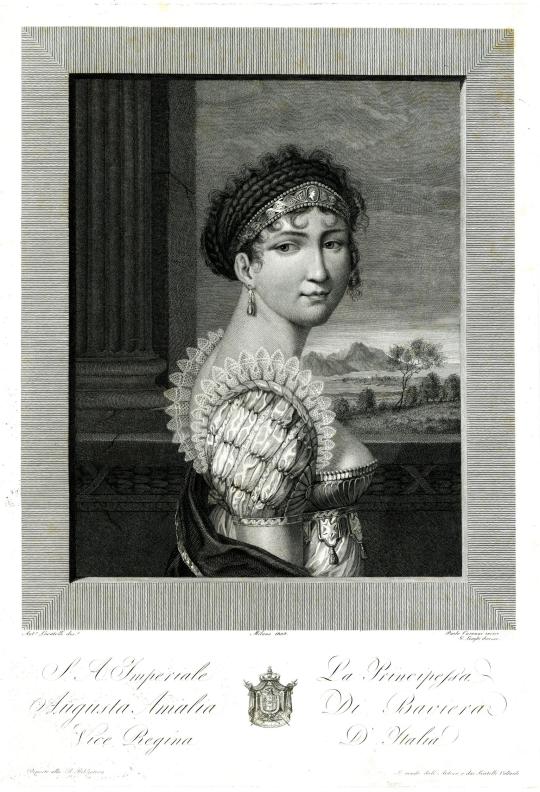
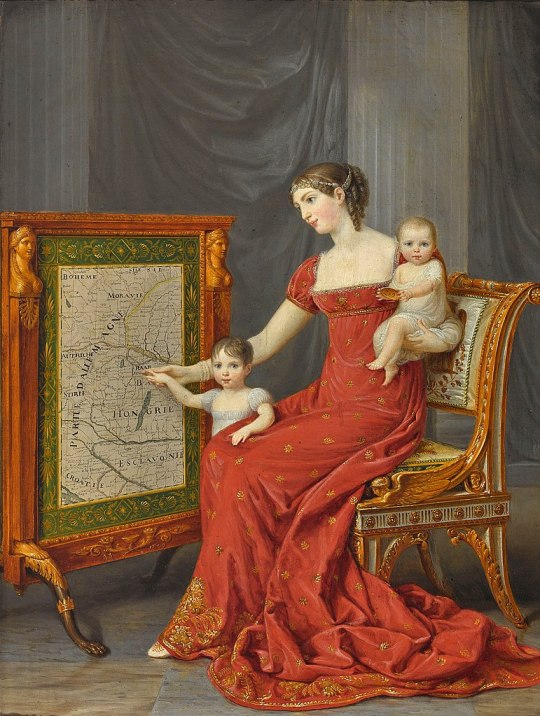
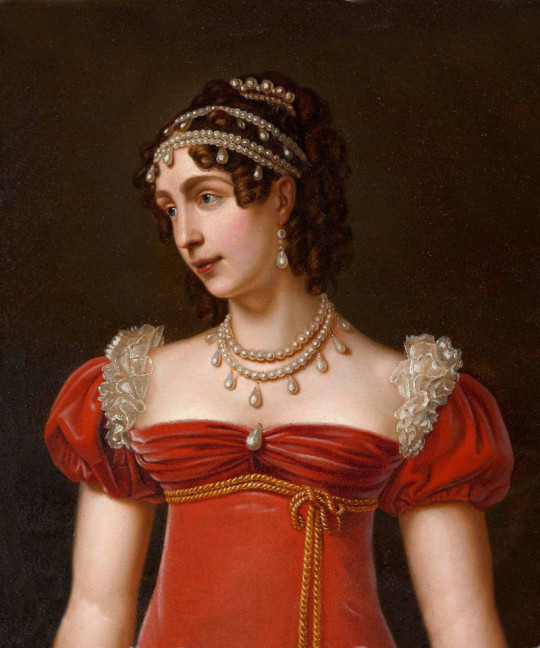



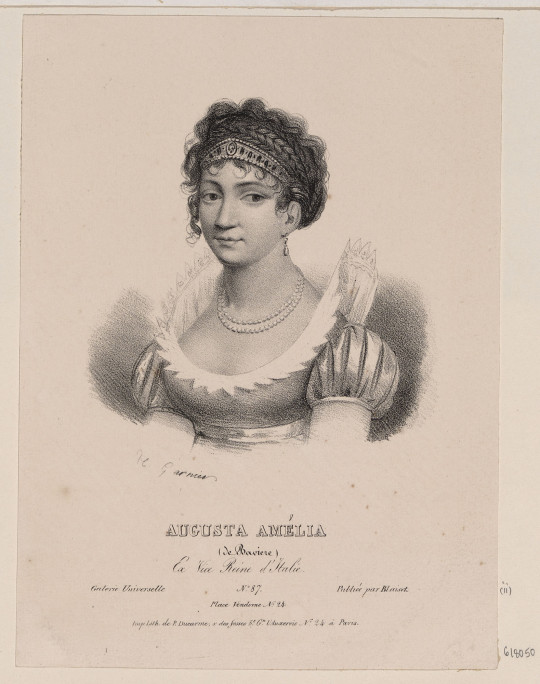


Augusta Amalia of Bavaria - She fell in love, but Napoléon intervened and she had to marry 1808 Empress Josephine’s son Eugéne to spare Bavaria from imperial wrath.
Top left: Augusta Amalia of Bavaria, bust length, wearing tiara with pearls, pearl earring, and low dress by Paolo Caronni and/or Giuseppe Longhi (British Museum). From their Web site 1705X2000 @300 2.1Mj.
Top right: 1809 Auguste Amalie de Beauharnais, Vizekönigin von Italien, mit ihren Töchtern Josephine und Eugenie by Andrea Appiani (location ?). From Wikimedia via pinterest.com/marcellagarsia/fashion-in-painting-xix-secolo/1800s/ 771X1023 @72 378kj.
Second row: 1810 Augusta Amalia Ludovika von Bayern, Duchess of Leuchtenberg by ? (location ?). From napoleondidthat.tumblr.com/post/122145342551/augusta-amalia 800X960 @72 270kj.
Third row left: 1814 Princess Augusta Amalia of Bavaria as a Vice-queen of Italy by ? (location ?). From csfd.cz/film/1010768-napoleons-erben-in-bayern-die-herzoge-von-leuchtenberg/galerie/?page=2 1268X1766 @144 4Mp.
Third row right: ca. 1815 Augusta-Amélie de Bavière by François Pascal Simon Gérard (Versailles). From art.rmngp.fr/en/library/artworks; erased cracks & spots w Pshop & enlarged 25% 609X936 @96 140kj.
Fourth row: ca. 1816 Auguste Amalie de Baviere by Joseph Karl Stieler (Château de Malmaison - Rueil-Malmaison, Île-de-France, France). From Wikinedia; erased cracks & flaws and fixed edges w Pshop 725X925 @72 1.3Mp.
Fifth row left: 1820 (or later) Augusta of Bavaria, Duchess of Leuchtenberg by Garnier (Royal Collection RCIN 618050), From their Web site 1579X2000 @300 956kj.
Fifth row right: 1824-1825 Auguste-Amélie de Bavière by Joseph Karl Stieler (Châteaux de Malmaison et Bois-Préau - Rueil-Malmaison, Île-de-France, France). From Wikimedia 1006X1254 @72 260kj.
Sixth row: ca. 1825 Auguste Amalie, Princess of Bayern by Joseph Karl Stieler (auctioned by Ketterer Kunst) From pinterest.com/AlexyMet/ritratti-aristocratici-eleganti/; fixed flaws and spots throughout image with Photoshop. 3003X4002 @300 4.1Mj. This dress is more in keeping with the 1830s than the 1820s.
#Empire fashion#French restoration era fashion#1800s fashion#1810s fashion#1820s fashion#1830s fashion#Augusta Amalia of Bavaria#curly hair#tiara#square décolletage#neckline ruff#Empire waistline#close skirt#quarter length close sleeves#Paolo Caronni#Andrea Appiani#Giuseppe Longhi#square neckline#hair jewelry#waist band#François Pascal Simon Gérard#Joseph Karl Stieler#feathered hat#high neckline#slashing#long sleeves#Garnier#scoop neckline#turban#robes
42 notes
·
View notes
Text
Why I love the Spymaster #103: He's in The Hay Wain!
Find my full series under the HELP I WUVS HIM tag.
I talk about the Spymaster's use of classic paintings of modern Western art in The Power of the Doctor elsewhere in my list. #61: Playing even more with gender! notes that he substitutes himself in three paintings into the position of women. #79: The Scream! 💔 points out that his use of the painting illustrates his struggles with mental health. #100: His art collection! examines why he turns to famous paintings that are considered classics. #101: He's the Mona Lisa! talks about the reasons for his self-insertion in that painting. #102: He's the girl with a pearl earring! discusses his use of that Vermeer portrait.
The mini essay addresses The Hay Wain: Landscape at Noon, an 1821 landscape painting by English painter John Constable. It shows a person driving a wooden wain [or wagon] pulled by three horses across the Stour River between Suffolk and Essex counties. The massive work is considered the artist's most recognizable image and one of the best and most popular English paintings. The site in Suffolk depicted in the painting is now a tourist attraction.
Here is a reproduction:

Of all the paintings that the Spymaster inserts himself into, The Hay Wain stands out for two reasons. First, it's much more familiar to English viewers in particular than the other paintings, which are internationally popular. Second, all the other paintings are closeups of recognizable individuals whose replacement with the Spymaster as Ra-Ra-Rasputin can be easily identified. In contrast, The Hay Wain depicts a large landscape in which the wagon driver is a very small part, not even facing the camera. The driver is an important piece of the painting, but not the focus.
Why might the Spymaster co-opt The Hay Wain, then, especially since, unlike the other paintings he puts himself in, the picture does not showcase his beautiful, attention-getting visage? I think the answer lies in the painting as a peculiarly English [that is, from England] icon. The painting illustrates an English scene--a picturesque, tranquil scene of an idealized, preindustrial, agricultural past. The painting is familiar to English viewers and considered a significant piece of early modern English culture. While The Hay Wain is not as old a picture as the Mona Lisa or Girl with a Pearl Earring, it's specifically English in a way that the other paintings are not.
Doctor Who is a British show created in an era [the late 1960s] when English colonial, economic, and cultural dominance was on the decline. In response to this perceived loss of power, new English cultural heroes developed for the post-WWII, post-imperial period. One such was Ian Fleming's James Bond [inspired by Jon Pertwee's miltary shenanigans, apparently!], an MI6 agent, who showcased British superiority by being the best spy in his fictional universe, owning and deploying the most innovative gadgets, and possessing heterosexuality so irresistible that it could even win over lesbians like Pussy Galore. [No, seriously, go read the novels. They're fascinating.] James Bond re-established British empire, one hot heterosexual encounter at a time.
Another new hero for England's post-imperial age was the Doctor. Though nominally an extraterrestrial from another planet, the Doctor is a very English alien. They belong to a caste-ridden society of great intellectual and scientific achievement that mirror's England's past as a great source of scientific and technological influence. Their status as Time Lord marks them as part of England's noble class, also termed lords. Their role as quasi-scientific explorer and inventor, bringing hope, goodness, and moral insight to the universe, reflects the way in which imperial Britons envisioned themselves as intrepid bearers of enlightenment to the ignorant masses around the world. The Doctor reinterprets English imperialism for a post-imperial age by focusing less on all those objectionable aspects of colonialism [intertwined racism, sexism, and classism] and more on the [supposed] positives: the excitement of space exploration, the intellectual possibilities offered by new nuclear and computing technology, the ways in which a representative of a "more developed" society [i.e., the Time Dorks] could help and improve those of a "less developed" society [i.e., humans].
Anyway, the Doctor is a peculiarly English alien, and The Hay Wain is a quintessentially English painting that talks about English identity: a rural, agrarian, self-sufficient, specifically masculine identity that was formed in an idealized past. The Hay Wain's nostalgic and idealized masculinity, independent and powerful, appeals to the Spymaster, who dislikes his dependence on the Doctor and who's always hearkening back to the "classics." Additionally, the painting's Englishness confers Englishness upon the Spymaster when he puts himself in it; he thus represents himself as just as English, just as legitimate, and just as important, as the Doctor. It's another attempt for him to assert his equality with the Doctor when he's feeling inferior.
@natalunasans @sclfmastery @whovianuncle @timeladyjamie @rowanthestrange
#the master#spymaster#the spymaster#doctor who#dw meta#HELP I WUVS HIM#sacha dhawan#the power of the doctor#the hay wain#john constable#post-imperial british heroes#james bond#ian fleming
8 notes
·
View notes
Text
Focus on Your Style with TheJewelryHut Designer Vintage Inspired Style Tahitian Pearls and Diamonds Gold Earrings

Beauty Should have no Boundary, and You Never have to Sacrifice when choosing a gemstone Earrings. Trust, Confidence, and Integrity. Capture Her Heart with Thejewelryhut Fancy designer Vintage Inspired Style Tahitian Pearls, The Treasures of the Sea, in 14 KT White Gold Earrings adorned with Two Genuine 8.00-8.50 mm Black Tahitian Pearls, and accented by Several Brilliant Round Shape Diamonds . The oriental pearl is known as the gem of the moon. They have been recognized as the emblem of modesty, chastity, and purity. They have also come to symbolize a happy marriage. Pearl is the birthstone for June and is among the most timeless, classic, and treasured of all gems and is the recommended jewelry gift for celebrating 3rd, and 30th wedding anniversary. Ready to ship in 3-5 Days.
If Not Now? Then, When? Shop TheJewelryHut Jewelry Gallery, and Order online Now: https://www.thejewelryhut.com/?page=search&itemvid=12D40BB4-E3DD-2820-78836D2518307F21
#earrings#earring#pearl earrings#pearl and diamonds earrings#sterling silver earrings#14 kt gold earrings#freshwater pearl earrings#akoya pearl earrings#tahitain pearl earrings#halo style earrings#dangle pearl earrings#pearl stud earrings#anniversary jewelry gift#birth stone pearl earring#june birth gemstone earrings#black dress event jewelry gift idea#jewelry near me#thejewelryhut. Jewelry on sale#Imperial pearl earrings collection
0 notes
Note
Asking Simblr: What's your tiara lore?

King Louis V owns a slew of jewels. Some as a monarch and some as a private individual. This royal collection, which can be traced back to the early 18th century, has always been vague and does not consist of the crown jewels or state regalia. Many of these jewels were acquired through purchases and gifts. However, many originated outside of the country and were brought to Sunderland during times of international conflicts, mainly the American Civil War, both world wars, and the Russian Revolution.
The collection is estimated to include hundreds of items, including 30 tiaras, 51 necklaces, 42 bracelets, 35 pairs of earrings, 18 rings, and an undisclosed amount of brooches, pendants, and watches. This current collection is managed by Lady Astrid Marie Mogh, RGO, who is the official Adviser and Curator to Their Majesties the King and Queen. Some specific tiaras within this collection are as follows:
Queen Anne's Fleur-de-lis tiara: This tiara was made for Queen Anne by Sunderland-based jeweller Addington & Co. the year after her husband ascended the throne. It is an enormous tiara set with spiralling diamonds. The ailing Anne lent the tiara to her daughter-in-law Katherine who wore it throughout her life. In turn, the tiara was lent to Tatiana, Princess of Danforth for long-term use following Katherine's death.
The Sunningdale Tiara: Another tiara made for Queen Anne in the 1930s. Named after the peerage of Anne's aristocratic parents, the tiara was made with the diamonds given by her parents on her wedding day in 1913. It was highly associated with Anne throughout her life and was worn by both Queen Irene and Princess Jaqueline on their wedding days. It has been lambasted by critics as an "ugly spiked tiara".
Grand Duchess Anastasia Tiara: This diamond and pearl tiara was inherited by Grand Duchess Anastasia, sister of King Nicholas, from their mother Queen Alexandra, a member of the Russian Imperial family. During the Russian Revolution and after Anastasia's 1919 murder, the tiara and many other jewels belonging to the Grand Duchess were smuggled back to Sunderland. The tiara has since been worn by Queen Irene on several occasions.
Strawberry Leaf Tiara: This tiara also has some history attached to it. It was commissioned and designed by King James in 1857 as a gift to his daughter-in-law, the controversial future Queen Rosalyn. Rosalyn, who came from an extremely wealthy American family, was a controversial royal bride due to her upbringing in the Antebellum South. During the American Civil War, she quickly became despised in pro-Unionist Sunderland. After the early death of her husband, King Louis IV, Roslyn lived a secluded life. The Strawberry Leaf tiara re-emerged in the public eye when it was worn by Queen Irene in the 90s, decades after Roslyn's death. Still, the tiara has some uncomfortable baggage attached to it and there was some outcry when Courtney, Duchess of Woodbine wore it on her wedding day.
Floral Wreath Tiara: This is a modern tiara, one of several designed by Cartier for Queen Katherine in the 1950s and 60s. It's a pretty versatile tiara which can be set with emeralds, pearls, or aquamarine. In 1993, it was worn by Princess Jaqueline for a formal portrait to mark her 18th birthday, a rare example of a non-married lady wearing a tiara.
6 notes
·
View notes
Video
tumblr

Chanel’s Extravagant New Line of High Jewelry
The 123-piece collection offers a stunning 55.5-carat diamond necklace fashioned after the famous N°5 bottle.
“I didn’t want this N°5 High Jewelry collection to be just a tribute,” says Patrice Leguéreau, director of Chanel’s Fine Jewelry Creation Studio, of the Parisian maison’s first jewels designed with its iconic fragrance in mind. “I conceived it as an immersive experience,” he says, “a journey into what constitutes the very soul and the secrets of the N°5 perfume.” Pioneering fashion titan, Gabrielle “Coco” Chanel created the fragrance in 1921 to offer an eau de parfum for the modern woman. It was the first of its kind by a couture house. It has remained a staple for women’s beauty cabinets around the world a century after its debut.
To capture the essence of the scent at its literal roots, Leguéreau toured the fields of flowers and plants in Grasse, home to Chanel’s fragrance headquarters, with the brand’s house perfumer, Olivier Polge. Those olfactory notes, along with key design elements such as the bottle, stopper and numeral, became reference points for the new line of ornate jewels.
Some of these references in the 123-piece collection are quite direct, such as a 55.5-carat diamond necklace fashioned with the iconic bottle as its centerpiece and a pair of diamond chandelier earrings, one of which drops from a number five. Others offer a more nuanced approach. The Bubbly Stopper bracelet in white and yellow gold, seen here, is set with a 47.06-carat, emerald-cut imperial topaz—a color that evokes the scent’s amber notes—punctuated with cultured pearls that mimic tiny droplets of liquid.
Chanel’s jewelry has more than a few visual cues with which to play; pearls, quilted bags, double C’s and tweed have all become synonymous with founder Gabrielle “Coco” Chanel’s elegant, cultivated style. But coming this year, on the centennial of Chanel No. 5, leaning into the brand’s signature scent for inspiration was, shall we say, right on the nose.
By Paige Reddinger.
#Chanel’s Extravagant New Line of High Jewelry#N°5 High Jewelry Collection#diamonds#diamond necklace#jewelry#luxury#luxury jewelry#luxury living#luxury lifestyle#billionaire#billionaire lifestyle#rich#the good life
10 notes
·
View notes
Text
HM Queen Elisabeth I I wedding dress and jewelry .
For her wedding dress, Elizabeth still required ration coupons to buy the material for her gown, designed by Norman Hartnell. The dress was "a duchesse satin bridal gown with motifs of star lilies and orange blossoms." Elizabeth's wedding shoes were made out of satin and were trimmed with silver and seed pearl. Elizabeth did her own makeup for the wedding. Her wedding bouquet was prepared by the florist M. H. Longman, and consisted of "white orchids with a sprig of myrtle". The myrtle was taken from "the bush grown from the original myrtle in Queen Victoria's wedding bouquet". The bouquet was returned to the abbey the day after the service to be laid on the tomb of the Unknown Warrior, following a tradition started by Elizabeth's mother at her wedding in 1923
Prince Philip turned to his mother, Princess Alice of Battenburg, for help when creating the ring. She gave him her royal wedding tiara, The prince used a 3-carat diamond from the storied tiara to create the famous engagement ring for Elizabeth
Other diamonds from Alice’s dismantled tiara were also used to make Philip’s wedding present to his bride , an elaborate diamond and platinum bracelet also made by the jewelers at Philip Antrobus . The tiara had Romanov roots — it was Alice’s wedding gift from Emperor Nicholas II and Empress Alexandra of Russia — so both the Queen’s engagement ring and the Edinburgh Wedding Bracelet feature diamonds with Russian imperial heritage and was designed from the Prince himself.Today, the bracelet is worn by the Duchess of Cambridge.
Queen Mary had given the fringe tiara to her daughter-in-law, Queen Elizabeth (better known to us as the Queen Mother), in 1936. The Queen Mum is the one who loaned the tiara to Princess Elizabeth for her wedding in 1947. (Queen Elizabeth II didn’t inherit the tiara until her mother’s death in 2002.) There was a bit of an infamous mishap with the tiara on the wedding day: as the princess was getting ready, the tiara frame suddenly snapped. Garrard was able to repair it, but you can see a gap in the tiara from the quick fix in the portraits from the wedding.
Since 1947, the tiara has been worn by two more British royal brides. The Queen Mum loaned it to Princess Anne for her first wedding in 1973. Earlier this year, the Queen loaned the tiara to Princess Beatrice for her wedding as well
The Queen Anne and Queen Caroline Pearl Necklaces
Pearls are a staple in Queen Elizabeth II’s jewelry wardrobe today, so it’s no surprise that she wore a two-stranded pearl necklace on her wedding day. These pearls, though, are particularly special. They’re actually two separate pearl necklaces, always worn together, that have been in the family for generations. If family tradition is correct, they’re among the oldest pieces of British royal jewelry still worn by the Queen. The smaller strand, made of 46 pearls, is said to have been worn by Queen Anne, the last Stuart monarch. The longer strand, which includes 50 pearls, is attributed to Caroline of Ansbach, the queen consort of George II. Queen Victoria’s jewel inventory of 1896, made by Garrard, notes the pearl necklaces and is the first recorded statement of their Stuart/Hanoverian provenance
The Duchess of Gloucester’s Diamond and Pearl Earrings
Like the rest of the jewels worn by Princess Elizabeth on her wedding day, her diamond and pearl cluster earrings were also family heirlooms. The earrings date to the first half of the nineteenth century; they were originally owned by Princess Mary, Duchess of Gloucester, one of the daughters of King George III. She bequeathed them to her niece, Princess Mary, Duchess of Teck in 1857; in turn, the Duchess of Teck bequeathed them to her daughter, Queen Mary, in 1897. The earrings originally included detachable diamond and pearl pendants, but those were made into a separate pair of earrings by Queen Mary .
The cluster earrings were relatively new to Princess Elizabeth’s collection. Queen Mary had given them to her granddaughter less than a year earlier, in January 1947, on the day that the royal family left for their tour of South Africa
Νυφικό και κοσμήματα Της ΑΜ Βασίλισσας Ελισαβετ Β’
Για το νυφικό της, η Ελισάβετ χρειαζόταν ακόμα κουπόνια για να αγοράσει το υλικό για το νυφικό της, σχεδιασμένο από τον Norman Hartnell. Το φόρεμα ήταν «ένα σατέν νυφικό με μοτίβα από αστεράκια και άνθη πορτοκαλιάς». Τα νυφικά παπούτσια της Ελισάβετ ήταν φτιαγμένα από σατέν και ήταν διακοσμημένα με ασήμι και μαργαριτάρια. Η Ελισάβετ έκανε το δικό της μακιγιάζ για τον γάμο. Η γαμήλια ανθοδέσμη της ετοίμασε ο ανθοπώλης M. H. Longman, και αποτελούνταν από «λευκές ορχιδέες με ένα κλωνάρι μυρτιάς». Το κλωνάρι μυρτιάς ηταν από την αρχική μυρτιά που φυτεύτηκε για την γαμήλια ανθοδέσμη της Βασίλισσας Βικτώριας». Η ανθοδέσμη επιστράφηκε στο αβαείο την επομένη της λειτουργίας για να κατατεθεί στον τάφο του Άγνωστου Πολεμιστή, σύμφωνα με μια παράδοση που ξεκίνησε η μητέρα της Ελισάβετ στο γάμο της το 1923
Ο πρίγκιπας Φίλιππος στράφηκε στη μητέρα του, την πριγκίπισσα Αλίκη της Ελλάδας Δανίας και Μπατενμπεργκ , για βοήθεια για τη δημιουργία του δαχτυλιδιού. Η Πριγκίπισσα Αλικη Του έδωσε τη βασιλική γαμήλια τιάρα της ως γαμήλιο δώρο και έτσι ο πρίγκιπας χρησιμοποίησε ένα διαμάντι 3 καρατίων από την περίφημη τιάρα για να δημιουργήσει το διάσημο δαχτυλίδι αρραβώνων για την Ελισάβετ
Άλλα διαμάντια από την αποσυναρμολογημένη τιάρα της Αλίκης χρησιμοποιήθηκαν επίσης για να κάνει το γαμήλιο δώρο του Φίλιππου στη νύφη του, ένα περίτεχνο βραχιόλι από διαμάντια και πλατίνα, φτιαγμένο επίσης από τους κοσμηματοπώλες του Philip Antrobus. Η τιάρα είχε ρίζες απο τους Ρομανόφ διότι ήταν το γαμήλιο δώρο στην Αλίκη από τον αυτοκράτορα Νικόλαο Β' και την αυτοκράτειρα Αλεξάνδρα της Ρωσίας - έτσι τόσο το δαχτυλίδι αρραβώνων της Βασίλισσας όσο και το γαμήλιο βραχιόλι του Δούκα του Εδιμβούργου διαθέτουν διαμάντια με ρωσική αυτοκρατορική κληρονομιά και σχεδιάστηκαν από τον ίδιο τον Πρίγκιπα. Σήμερα, το βραχιόλι φοράει και η Δούκισσα του Κέμπριτζ Καθριν .
Η Βασίλισσα Μαίρη είχε δώσει την διαμαντενια τιάρα στη νύφη της, Βασίλισσα Ελισάβετ (γνωστή σε εμάς ως Βασίλισσα Μητέρα), το 1936. Η βασίλισσα μαμά είναι αυτή που δάνεισε την τιάρα στην πριγκίπισσα Ελισάβετ για τον γάμο της το 1947. (Η Βασίλισσα Ελισάβετ II δεν κληρονόμησε την τιάρα μέχρι τον θάνατο της μητέρας της το 2002.) Υπήρξε ένα περιβόητο ατύχημα με την τιάρα την ημέρα του γάμου: καθώς η πριγκίπισσα ετοιμαζόταν, το πλαίσιο της τιάρας έσπασε ξαφνικά. Ο Garrard μπόρεσε να το επισκευάσει, αλλά μπορείτε να δείτε ένα κενό στην τιάρα από τη γρήγορη επιδιόρθωση στα πορτρέτα του γάμου.
Από το 1947, η τιάρα φορέθηκε από δύο ακόμη βρετανικές βασιλικές νύφες. Η βασίλισσα μαμά το δάνεισε στην πριγκίπισσα Άννα για τον πρώτο της γάμο το 1973. Το 2020 η βασίλισσα δάνεισε την τιάρα στην εγγονή της πριγκίπισσα Βεατρίκη και για τον γάμο της
Τα μαργαριταρένια κολιέ της Βασιλισσας Αννας και Βασίλισσας Καρολίνας
Τα μαργαριτάρια είναι βασικό στοιχείο στη γκαρνταρόμπα κοσμημάτων της Βασίλισσας Ελισάβετ Β' σήμερα, επομένως δεν αποτελεί έκπληξη το γεγονός ότι φόρεσε ένα δίκλωνο μαργαριτάρι κολιέ την ημέρα του γάμου της. Αυτά τα μαργαριτάρια, όμως, είναι ιδιαίτερα ξεχωριστά. Στην πραγματικότητα είναι δύο ξεχωριστά μαργαριταρένια κολιέ, που φοριούνται πάντα μαζί, που υπάρχουν στην οικογένεια για γενιές. Αν η οικογενειακή παράδοση είναι σωστή, είναι από τα παλαιότερα βρετανικά βασιλικά κοσμήματα που φορούσε ακόμα η Βασίλισσα. Το μικρότερο κολιέ , φτιαγμένο από 46 μαργαριτάρια, λέγεται ότι φορέθηκε από τη βασίλισσα Άννα, την τελευταία μονάρχη των Στιούαρτ . Το μακρύτερο κολιέ , που περιλαμβάνει 50 μαργαριτάρια, αποδίδεται στην Καρολίνα του Άνσμπαχ, τη βασίλισσα σύζυγο του Γεωργίου Β'. Ο κατάλογος κοσμημάτων της Βασίλισσας Βικτώριας το 1896, που έγινε από τον Garrard, σημειώνει τα μαργαριταρένια περιδέραια και είναι η πρώτη καταγεγραμμένη δήλωση της προέλευσής τους από Stuart/Hanoverian
Τα σκουλαρίκια με διαμάντια και μαργαριτάρια της Δούκισσας του Γκλόστερ
Όπως και τα υπόλοιπα κοσμήματα που φορούσε η πριγκίπισσα Ελισάβετ την ημέρα του γάμου της, τα σκουλαρίκια της με διαμάντια και μαργαριτάρια ήταν επίσης οικογενειακά κειμήλια. Τα σκουλαρίκια χρονολογούνται στο πρώτο μισό του δέκατου ένατου αιώνα. αν��καν αρχικά στην πριγκίπισσα Μαρία, Δούκισσα του Γκλόστερ, μία από τις κόρες του Βασιλιά Γεωργίου Γ'. Τα κληροδότησε στην ανιψιά της, πριγκίπισσα Μαρία, Δούκισσα του Τεκ το 1857. με τη σειρά της, η Δούκισσα του Τεκ τα κληροδότησε στην κόρη της, Βασίλισσα Μαρία, το 1897. Τα σκουλαρίκια αρχικά περιλάμβαναν αποσπώμενα μενταγιόν με διαμάντια και μαργαριτάρια, αλλά αυτά έγιναν ένα ξεχωριστό ζευγάρι σκουλαρίκια από τη Βασίλισσα Μαρία.
Τα σκουλαρίκια ήταν σχετικά νέα στη συλλογή της Πριγκίπισσας Ελισάβετ. Η βασίλισσα Μαρία τα είχε δώσει στην εγγονή της λιγότερο από ένα χρόνο νωρίτερα, τον Ιανουάριο του 1947, την ημέρα που η βασιλική οικογένεια έφυγε για την περιοδεία της στη Νότια Αφρική
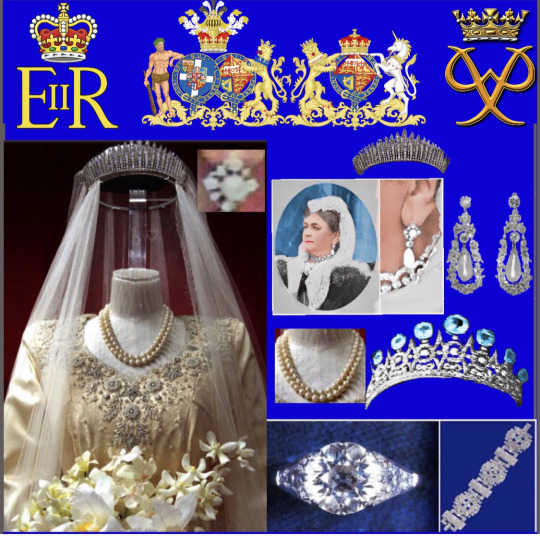

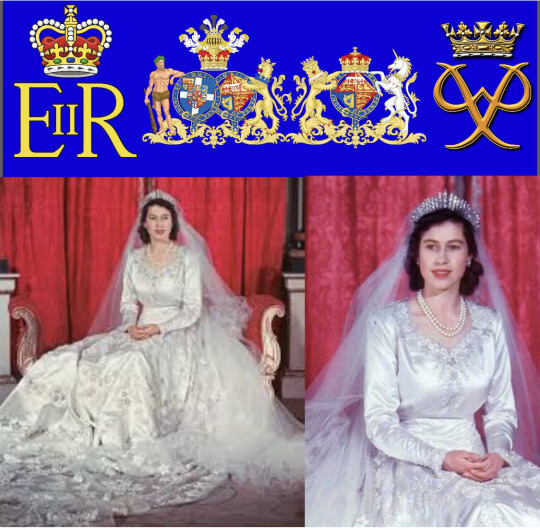

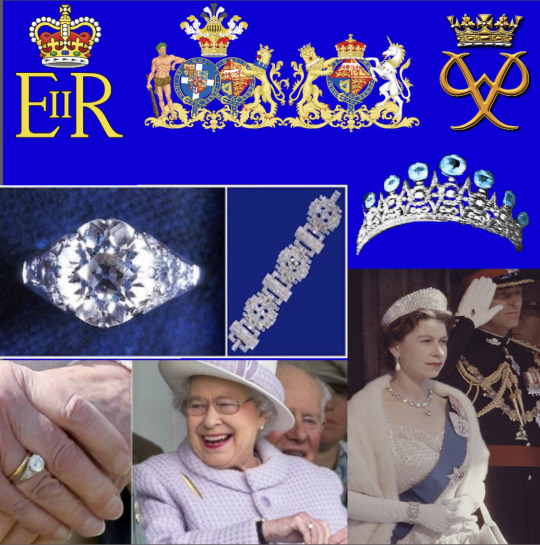
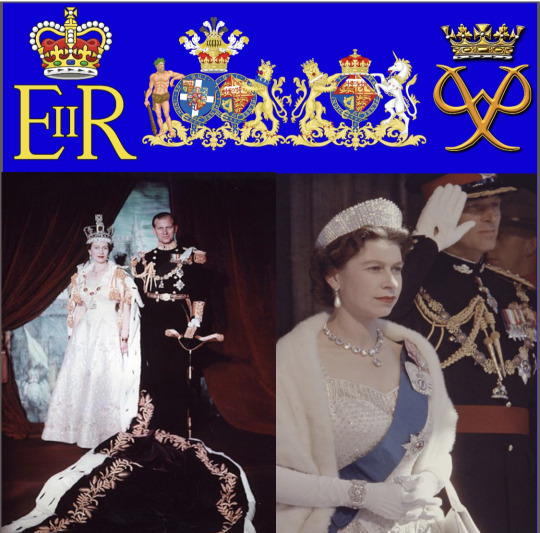



#kingconstantine#danishroyalfamily#crownprincepavlos#queenannemarie#greek royal family#house of romanov#greekroyals#crownprincessmariechantal#danishroyals#princeconstantinealexios#princess theodora#princessmarieolympia#princessalexia#princessnina#princesseirini#princesstatiana#princenikolaos#princeodyseaskimon#princearistidesstavros#princeachileasandreas
12 notes
·
View notes
Text
TIRH, The Imperial Duke and Duchess of Kahn Leave The Cathedral and Present Themselves As a Married Couple For The First Time!!!
HIRH Prince Imperial Darius, now the Imperial Duke of Kahn, joyfully presented his Imperial Duchess to the surrounding crowd.

The crowd went wild when the newly weds exited the Cathedral. Looking every inch the Imperial Princess, our new Imperial Duchess waved graciously to the crowd, putting much of her royal training to good use.



After much encouragement, and the almost immediate chanting of ''Kiss, Kiss, Kiss'' from the crowd, TIRH happily obliged and shared their second kiss as a married couple on the Cathedral steps.



The pair looked over the moon, and couldn't keep their eyes off of each other. The pair proceeded slowly down the Cathedral steps to the armed salute of the awaiting guards. Now that we can see HIRH dress in all its glory we can no see that, her something borrowed and old were the lotus necklace and matching pearl earrings, borrowed from the Imperial Royal collection; her something new was the new custom made tiara, designed for her by her husband. Apparently, HIRH did not know the Imperial Prince had a tiara made for her and was surprised by it this morning. HIRH had already visited the family vault with HIRM, Empress Sheva, and picked out another tiara for the occasion. Regardless, the tiara goes perfectly with the dress, maybe HIRH had some inside help? Her something blue, are the Sulani Tulips, flown especially in to represent the Kingdom of her birth.


The couple have been invested with a newly created Dukedom, and will hence forth be known as the TIRH, Prince Imperial Darius and Princess Imperial Alysha; The Imperial Duke and Duchess of Kahn. The Dukedom has been newly created, in honour of HIRH Father, Prince-Consort Ngata, to honour his Family name. The Dukedom, Kahn, is an homage to Kahananui, HIRM family name before his marriage to our Empress. HIRM was very emotional when watching his son get married, and is said to be extremely touched by the gesture.
TIRH, will now ride the carriage too Khartoum House, were they will have their wedding reception.
#ts4monarchy#ts4 monarchy#ts4blacksims#ts4 blacksims#ts4blackroyals#ts4 blackroyals#ts4 royal wedding
9 notes
·
View notes